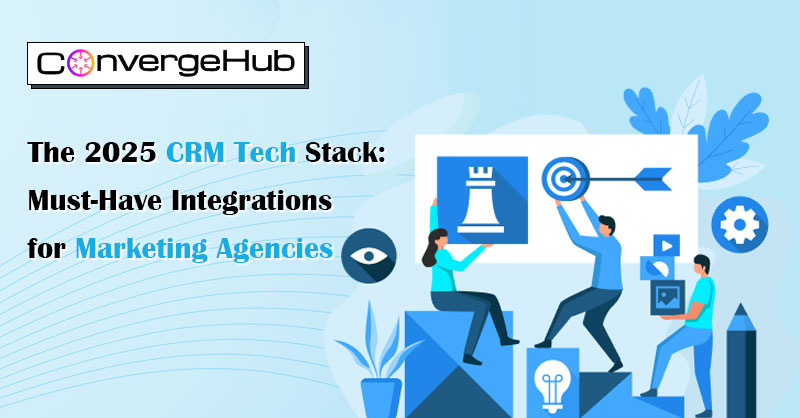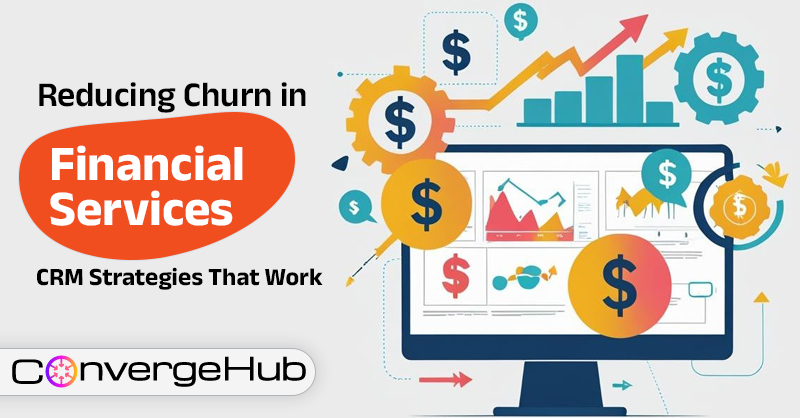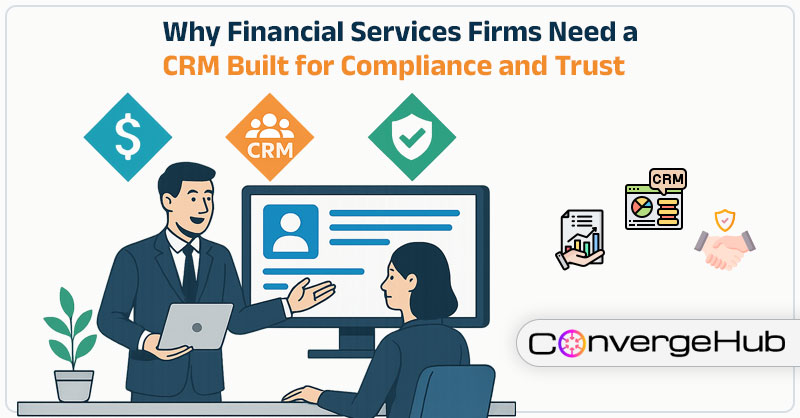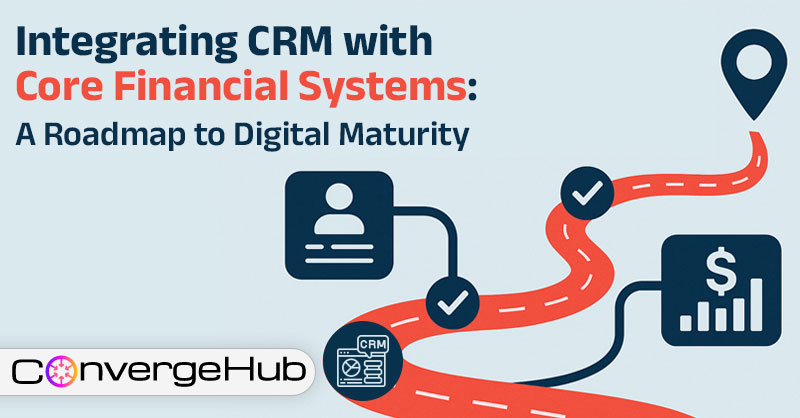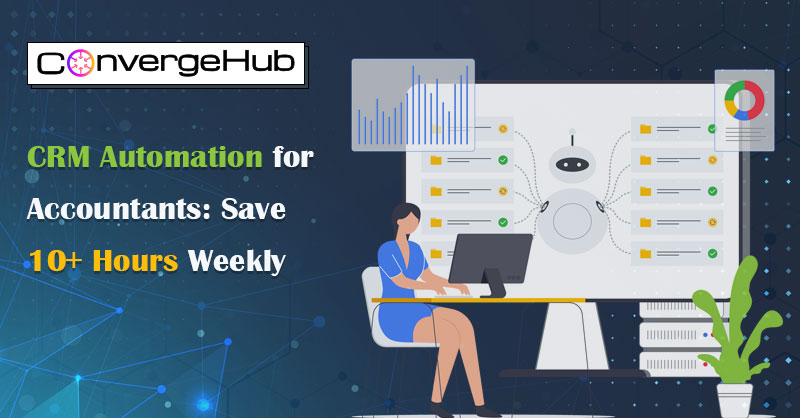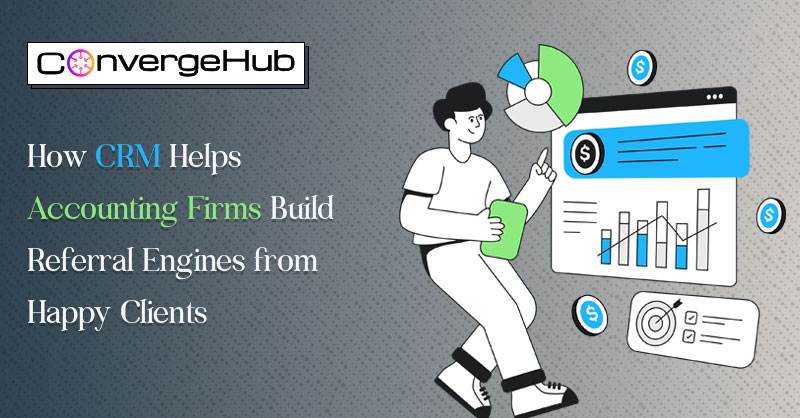| | ||||||||||||
|
Year: 2025
A growth hack
The 2025 CRM Tech Stack: Must-Have Integrations for Marketing Agencies
In the fast-evolving world of digital marketing, agility isn’t optional—it’s essential. As client expectations rise and campaign complexity grows, marketing agencies must rely on a tech stack that’s not just powerful, but seamlessly connected. At the heart of this stack lies the CRM: the command center for client data, campaign performance, and team collaboration.
But in 2025, a CRM alone isn’t enough. To truly unlock its potential, agencies need a CRM ecosystem—a tightly integrated suite of tools that spans marketing automation, analytics, project management, and more. In this blog, we’ll explore the must-have CRM integrations that marketing agencies should prioritize to stay competitive, efficient, and client-centric.
Why CRM Is the Core of the Marketing Tech Stack
Marketing agencies juggle dozens of tools—from email platforms and ad managers to design suites and analytics dashboards. Without a central hub, data becomes siloed, workflows break down, and client insights get lost in the noise.
A modern CRM like ConvergeHub solves this by:
- Centralizing client and campaign data
- Automating repetitive tasks
- Tracking interactions across channels
- Enabling collaboration across teams
- Providing real-time performance insights
When integrated with the right tools, CRM becomes the brain of your agency driving smarter decisions, faster execution, and better client outcomes.
Must-Have CRM Integrations for Marketing Agencies in 2025
1. Marketing Automation Platforms (MAPs)
Why it matters: Automation is the backbone of scalable marketing. Integrating your CRM with platforms like Mailchimp, ActiveCampaign, or HubSpot Marketing allows agencies to:
- Sync contact lists and segments
- Trigger automated email sequences based on CRM data
- Track campaign engagement directly within the CRM
ConvergeHub Advantage: Native automation tools plus easy integration with third-party MAPs means agencies can run personalized campaigns without switching tabs.
2. Social Media Management Tools
Why it matters: Social media is a key touchpoint for brand visibility and engagement. Integrating tools like Buffer, Hootsuite, or Sprout Social with your CRM enables:
- Unified client profiles with social engagement history
- Scheduling and tracking posts from within the CRM
- Monitoring sentiment and mentions tied to client accounts
Pro Tip: Use CRM tags to segment clients based on social responsiveness and tailor outreach accordingly.
3. Project Management and Collaboration Platforms
Why it matters: Agencies thrive on collaboration. Integrating tools like Trello, Asana, or ClickUp ensures that campaign tasks, deadlines, and deliverables are aligned with client records.
- Assign tasks linked to CRM contacts or deals
- Track project status alongside client communications
- Improve internal accountability and transparency
ConvergeHub Insight: Built-in task and workflow management features reduce the need for external tools, but integrations offer flexibility for larger teams.
4. Analytics and Business Intelligence (BI) Tools
Why it matters: Data-driven decisions are non-negotiable. Integrating BI platforms like Google Data Studio, Tableau, or Looker allows agencies to:
- Visualize CRM data in custom dashboards
- Combine CRM metrics with ad spend, traffic, and conversion data
- Share performance reports with clients in real time
Use Case: A campaign manager can pull lead conversion data from ConvergeHub and overlay it with Google Ads performance to optimize budget allocation.
5. Ad Management Platforms
Why it matters: Paid media is a major revenue driver. Integrating platforms like Google Ads, Meta Ads Manager, or LinkedIn Campaign Manager with your CRM enables:
- Attribution tracking from ad click to CRM conversion
- Real-time syncing of leads and campaign data
- ROI analysis across channels
ConvergeHub Tip: Use CRM scoring to prioritize leads from high-performing ad campaigns and route them to sales or account managers.
6. Customer Support and Helpdesk Tools
Why it matters: Client retention depends on responsive support. Integrating tools like Zendesk, Freshdesk, or Intercom with your CRM allows agencies to:
- View support tickets alongside client history
- Track resolution times and satisfaction scores
- Identify recurring issues across accounts
Strategic Benefit: Support data enriches CRM profiles, helping account managers anticipate needs and improve service quality.
7. E-Signature and Document Management Tools
Why it matters: Contracts, proposals, and approvals are part of agency life. Integrating tools like DocuSign, HelloSign, or PandaDoc streamlines:
- Document creation and tracking
- Signature workflows linked to CRM deals
- Secure storage and compliance
Efficiency Boost: Automate proposal follow-ups based on signature status tracked in the CRM.
8. Calendar and Scheduling Tools
Why it matters: Time is money. Integrating tools like Calendly, Google Calendar, or Microsoft Outlook helps agencies:
- Schedule meetings directly from CRM contact records
- Avoid double-booking and missed follow-ups
- Sync reminders and availability across teams
ConvergeHub Feature: Built-in calendar sync ensures that client meetings and internal reviews are always aligned.
9. Content Management Systems (CMS)
Why it matters: Agencies often manage client websites and landing pages. Integrating CMS platforms like WordPress, Webflow, or Drupal allows:
- Tracking form submissions and site behavior in the CRM
- Syncing lead data from landing pages to campaigns
- Personalizing content based on CRM segmentation
Growth Opportunity: Use CRM insights to inform content strategy and A/B testing.
10. Payment and Invoicing Platforms
Why it matters: Financial transparency builds trust. Integrating tools like Stripe, QuickBooks, or Xero with your CRM enables:
- Tracking invoices and payment status per client
- Automating billing reminders and follow-ups
- Linking financial data to campaign ROI
Agency Win: Reduce billing friction and improve cash flow visibility—all within your CRM dashboard.
Building a Cohesive CRM Ecosystem
Integrating tools isn’t just about convenience—it’s about creating a connected experience for your team and clients. Here’s how to build a cohesive CRM ecosystem:
- Start with your workflows: Map out how data flows across departments.
- Prioritize integrations that reduce friction: Focus on tools that eliminate manual entry and improve visibility.
- Ensure data hygiene: Use CRM rules to prevent duplication and maintain accuracy.
- Train your team: Adoption is key—make sure everyone understands how integrations enhance their role.
With ConvergeHub’s flexible architecture and API capabilities, agencies can build a tech stack that evolves with their needs.
Future-Proofing Your Agency with CRM Integrations
As AI, automation, and personalization continue to reshape marketing, CRM integrations will become even more critical. Expect deeper connections between CRM and:
- AI-powered content tools (e.g., Jasper, Copy.ai)
- Voice and conversational platforms (e.g., chatbots, voice assistants)
- Predictive analytics engines for lead scoring and campaign forecasting
Agencies that embrace integration not only streamline operations—they position themselves as strategic partners to their clients.
Final Thoughts: CRM as the Agency Growth Engine
In 2025, marketing agencies can’t afford to operate in silos. A well-integrated CRM tech stack is the foundation for scalable growth, smarter campaigns, and stronger client relationships. With ConvergeHub at the center, agencies gain the flexibility to connect their favorite tools, automate their workflows, and deliver measurable impact.
Whether you’re refining your stack or building it from scratch, start with CRM—and build outward. Because in the agency world, integration isn’t just a feature. It’s a strategy.
The Move That Turns a No into Yes
| | |||||||||||||||||||||||||||||||||||||
|
Reducing Churn in Financial Services: CRM Strategies That Work
In the high-stakes world of financial services, client retention isn’t just a metric—it’s a mandate. Whether you’re managing wealth portfolios, offering insurance solutions, or providing lending services, the cost of losing a client often exceeds the cost of acquiring a new one. Yet, many firms still struggle to identify churn risks early and act decisively.
This is where a robust Customer Relationship Management (CRM) system like ConvergeHub becomes a game-changer. By centralizing client data, automating engagement, and surfacing actionable insights, CRM empowers financial institutions to reduce churn and build lasting relationships.
Let’s explore how.
Understanding the Cost of Churn in Financial Services
Churn isn’t just about lost revenue—it’s about lost trust, missed opportunities, and reputational risk. Consider these impacts:
- Revenue Drain: A single lost client can mean thousands in lost fees, commissions, or interest income.
- Referral Loss: Disengaged clients don’t refer others—happy ones do.
- Operational Inefficiency: Constantly onboarding new clients strains resources and increases compliance risk.
According to Bain & Company, increasing customer retention rates by just 5% can boost profits by 25% to 95%. In financial services, where lifetime value is high, the stakes are even greater.
Why Clients Leave: Common Churn Triggers
Before we dive into CRM strategies, it’s important to understand why clients churn. Common reasons include:
- Lack of Personalization: Generic communication erodes trust.
- Poor Onboarding: A confusing or slow start sets the wrong tone.
- Inconsistent Service: Delays, errors, or lack of follow-up frustrate clients.
- Limited Engagement: Clients feel forgotten between transactions.
- Better Offers Elsewhere: Competitors lure clients with more tailored solutions.
The good news? Each of these triggers can be addressed with smart CRM strategies.
CRM Strategies That Reduce Churn
1. 360-Degree Client View for Proactive Engagement
A fragmented view of client data often leads to missed opportunities and impersonal service. ConvergeHub’s 360-degree dashboard consolidates every interaction, transaction, and preference into a single, accessible profile. This empowers financial advisors to understand the full context of a client’s journey—whether it’s a recent inquiry, a pending loan application, or a milestone like a birthday or investment anniversary.
With this holistic view, firms can engage proactively rather than reactively. Advisors can schedule timely follow-ups, send personalized messages, and anticipate client needs before they’re voiced. This kind of thoughtful engagement builds trust and loyalty, making clients feel seen and valued—two critical factors in reducing churn.
2. Automated Workflows to Prevent Drop-Offs
Manual processes are prone to delays and inconsistencies, especially in high-touch industries like finance. ConvergeHub’s automation capabilities allow firms to design workflows that guide clients through key stages—onboarding, document submission, policy renewals, and service follow-ups. These workflows ensure that no step is missed and that clients receive timely communication at every touchpoint.
Beyond efficiency, automation reinforces reliability. Clients are less likely to disengage when they experience smooth, predictable service. For example, an automated reminder for a portfolio review or loan renewal not only keeps the client informed but also signals that the firm is actively managing their financial well-being. This kind of consistent experience is essential for retention.
3. Segmentation for Targeted Retention Campaigns
Not all clients are at equal risk of churn, and treating them as a monolith can dilute retention efforts. ConvergeHub’s segmentation tools allow financial firms to categorize clients based on behavior, engagement level, product usage, and value. This enables the creation of targeted campaigns that speak directly to the needs and concerns of each group.
For instance, clients who haven’t interacted in 60 days can be flagged as “dormant” and sent a personalized re-engagement offer. High-value clients might receive exclusive insights or loyalty perks. By tailoring outreach to specific segments, firms can address churn risks more effectively and demonstrate that they understand and prioritize individual client needs.
4. Sentiment Tracking and Feedback Loops
Client sentiment is often the earliest indicator of churn—but it’s easy to miss without the right tools. ConvergeHub enables firms to integrate surveys, feedback forms, and sentiment analysis into their CRM workflows. This allows for real-time monitoring of client satisfaction and uncovers issues before they escalate into attrition.
Feedback loops also create a culture of responsiveness. When clients see that their input leads to tangible improvements, they’re more likely to stay engaged and loyal. Whether it’s a quick post-meeting survey or a quarterly satisfaction check-in, these touchpoints help financial firms stay attuned to client emotions and act swiftly to preserve relationships.
5. Advisor Performance Insights
Client retention isn’t just about systems—it’s about people. ConvergeHub tracks advisor performance metrics such as follow-up rates, resolution times, and client satisfaction scores. This data helps managers identify top performers, uncover training needs, and ensure that every advisor delivers consistent, high-quality service.
When advisors are equipped with insights and held accountable for client outcomes, they become more proactive and client-centric. This translates into better conversations, faster resolutions, and stronger relationships. Ultimately, empowered advisors are the frontline defense against churn—and CRM gives them the tools to succeed.
Real-World Impact: A Hypothetical Scenario
Imagine a mid-sized wealth management firm using ConvergeHub. They notice a segment of clients hasn’t logged into their portal or responded to emails in 90 days. The CRM flags these clients as “at-risk.”
- An automated workflow kicks in:
- A personalized email offers a free portfolio review.
- A follow-up task is assigned to the advisor.
- Feedback is collected post-meeting.
Result? 60% of flagged clients re-engage, and 20% increase their investment. That’s CRM-driven retention in action.
Future-Proofing Retention with AI and Predictive Analytics
The next frontier in churn reduction is predictive CRM. ConvergeHub’s AI capabilities can:
- Forecast churn risk based on behavioral patterns.
- Recommend next-best actions for advisors.
- Surface upsell opportunities aligned with client goals.
This shifts retention from reactive to proactive—giving firms a competitive edge.
Final Thoughts: CRM as a Retention Engine
Reducing churn in financial services isn’t about chasing clients—it’s about understanding them. With ConvergeHub, firms gain the ability to build trust through personalized, timely engagement and automate consistency across every stage of the client journey. From onboarding to renewal, every interaction becomes an opportunity to reinforce value and deepen relationships.
More than just a data repository, CRM serves as a strategic engine for retention. By surfacing actionable insights, enabling proactive outreach, and aligning advisor performance with client expectations, ConvergeHub empowers financial institutions to stay ahead of churn. In a sector where loyalty drives long-term growth, investing in CRM isn’t optional—it’s essential.
Maybe your best lead isn’t dead… yet
| | |||||||||||||||||||||||||||||||
|
Why Financial Services Firms Need a CRM Built for Compliance and Trust
In today’s hyper-regulated financial landscape, trust isn’t just a virtue—it’s a competitive advantage. Financial services firms operate under intense scrutiny, with evolving compliance mandates and rising customer expectations. Amid this complexity, a Customer Relationship Management (CRM) system isn’t just a tool for managing leads and contacts—it’s a strategic asset that can reinforce compliance, build trust, and drive long-term growth.
But not all CRMs are created equal. Generic platforms may offer flashy dashboards and automation features, but they often fall short when it comes to the nuanced needs of financial institutions. What’s needed is a CRM purpose-built for compliance and trust—one that understands the regulatory terrain and empowers firms to deliver secure, transparent, and personalized experiences.
The Compliance Imperative in Financial Services
Financial services firms—whether banks, wealth managers, insurance providers, or fintech startups—are governed by a complex web of regulations:
- Know Your Customer (KYC) and Anti-Money Laundering (AML) requirements
- General Data Protection Regulation (GDPR) and CCPA for data privacy
- SEC, FINRA, and other jurisdictional mandates for reporting and transparency
Non-compliance isn’t just risky—it’s costly. Regulatory fines, reputational damage, and client attrition can cripple even well-established firms. That’s why compliance must be embedded into every customer interaction, not bolted on as an afterthought.
A CRM built for compliance ensures that:
- Every client profile includes mandatory KYC documentation
- Communication logs are timestamped and auditable
- Data access is role-based and encrypted
- Automated alerts flag potential compliance breaches
This isn’t just about ticking boxes—it’s about creating a culture of accountability and transparency.
Trust Is the Currency of Financial Relationships
In financial services, trust is earned through consistency, clarity, and care. Clients entrust firms with their life savings, retirement plans, and financial futures. One misstep—whether a data breach, a missed follow-up, or a tone-deaf campaign—can erode that trust instantly.
A compliance-ready CRM helps build trust in several key ways:
- Secure Data Handling: Clients know their sensitive financial data is protected through encryption, access controls, and audit trails.
- Personalized Engagement: Advisors can tailor recommendations based on a 360° view of the client’s financial history, goals, and preferences.
- Transparent Communication: Every email, call, and meeting is logged, ensuring clients receive consistent and informed service.
- Proactive Risk Management: Automated workflows can flag unusual activity or gaps in documentation, allowing firms to act before issues escalate.
Trust isn’t just about avoiding mistakes—it’s about showing clients that their financial well-being is your top priority.
Why Generic CRMs Fall Short
Many financial firms start with off-the-shelf CRMs, only to discover their limitations:
| Feature | Generic CRM | Compliance-Ready CRM |
| KYC/AML Integration | Manual or absent | Built-in workflows and document tracking |
| Audit Trails | Basic activity logs | Detailed, timestamped, and exportable logs |
| Data Privacy Controls | Limited | Granular role-based access and encryption |
| Regulatory Reporting | Requires customization | Pre-configured templates and automation |
| Financial Product Mapping | Generic fields | Custom modules for loans, policies, portfolios |
The result? Teams waste time on workarounds, compliance officers scramble to extract data, and clients receive fragmented service.
The Strategic Advantage of a Compliance-Ready CRM
A CRM designed for financial services doesn’t just solve problems—it unlocks new possibilities:
1. Streamlined Onboarding
Automated KYC workflows, e-signature integration, and document checklists reduce onboarding time and ensure regulatory completeness.
2. Unified Client View
From investment history to communication logs, advisors get a holistic view of each client, enabling smarter recommendations and deeper relationships.
3. Real-Time Compliance Monitoring
Dashboards highlight missing documents, expired IDs, or unusual transactions, allowing firms to act swiftly and avoid penalties.
4. Scalable Data Governance
As firms grow, so do their data risks. A compliance-ready CRM scales with your business, ensuring consistent governance across teams and geographies.
5. Enhanced Client Confidence
When clients see that your firm prioritizes security, transparency, and personalized service, they’re more likely to stay loyal—and refer others.
Why ConvergeHub Is Built for This Moment
ConvergeHub isn’t just another CRM—it’s a platform engineered for the unique demands of financial services. Here’s how it stands apart:
- Compliance-First Architecture: From KYC modules to encrypted data storage, ConvergeHub embeds compliance into every layer.
- Customizable Workflows: Tailor onboarding, servicing, and reporting processes to match your regulatory environment.
- Audit-Ready Reporting: Generate detailed logs and reports for internal audits or regulatory submissions with a few clicks.
- Client-Centric Design: Deliver personalized, consistent service across channels—email, phone, portal, and more.
- Seamless Integrations: Connect with core financial systems, document management tools, and analytics platforms.
Whether you’re a boutique wealth advisory or a multi-branch financial institution, ConvergeHub helps you stay compliant, build trust, and grow with confidence.
The Bottom Line
In an industry where trust and compliance are non-negotiable, your CRM can’t be an afterthought. It must be a strategic ally—one that empowers your team, protects your clients, and positions your firm for sustainable success.
Financial services firms that invest in a compliance-ready CRM aren’t just avoiding risk—they’re building a foundation for deeper relationships, smarter decisions, and long-term growth.
Integrating CRM with Core Financial Systems: A Roadmap to Digital Maturity
In today’s hyper-connected financial landscape, digital maturity isn’t just a competitive advantage—it’s a survival imperative. Financial institutions are under increasing pressure to deliver seamless customer experiences, ensure regulatory compliance, and optimize operational efficiency. At the heart of this transformation lies a powerful synergy: integrating Customer Relationship Management (CRM) systems with core financial platforms.
This integration is more than a technical upgrade—it’s a strategic leap toward holistic customer intelligence, real-time decision-making, and scalable growth. Let’s explore how financial organizations can navigate this journey, the challenges they may face, and the roadmap to achieving true digital maturity.
Why Integration Matters: The Strategic Imperative
CRM systems are designed to manage customer interactions, track engagement, and personalize communication. Core financial systems, on the other hand, handle transactional data, account management, compliance, and risk analytics. When these two ecosystems operate in silos, institutions miss out on critical insights and operational agility.
Benefits of CRM–Financial System Integration:
- Unified Customer View: Combine behavioral data with financial history for 360° customer profiles.
- Enhanced Personalization: Deliver tailored financial products and services based on real-time insights.
- Operational Efficiency: Automate workflows across departments, reducing manual errors and redundancies.
- Regulatory Compliance: Ensure consistent data governance and audit trails across platforms.
- Revenue Growth: Identify cross-sell and upsell opportunities with predictive analytics.
Key Integration Components: What Needs to Connect?
Successful integration requires more than just API connectivity—it demands strategic alignment across data, processes, and user experience.
1. Data Synchronization
- Real-time syncing of customer profiles, transaction histories, and financial product usage.
- Standardized data formats to ensure consistency across platforms.
2. Process Automation
- Trigger-based workflows (e.g., loan approval, KYC updates, payment reminders).
- Integration with marketing automation tools for targeted campaigns.
3. Security & Compliance
- Role-based access controls and encryption protocols.
- Audit logs and compliance reporting aligned with financial regulations (e.g., GDPR, PCI DSS).
4. Analytics & Reporting
- Unified dashboards combining CRM engagement metrics with financial KPIs.
- AI-driven insights for customer segmentation, risk scoring, and churn prediction.
Integration Models: Choosing the Right Approach
Depending on organizational maturity and infrastructure, financial institutions can adopt different integration models:
| Model | Description | Best For |
| Point-to-Point | Direct connections between CRM and financial systems | Small-scale setups with limited data flow |
| Middleware-Based | Uses integration platforms (e.g., MuleSoft, Dell Boomi) to manage data exchange | Mid-sized firms seeking scalability |
| Unified Platform | CRM and financial modules within a single ecosystem (e.g., QuantmX, Corelynx) | Enterprises aiming for full-stack digital transformation |
The Roadmap to Digital Maturity
Achieving seamless integration is a phased journey. Here’s a strategic roadmap financial institutions can follow:
Phase 1: Assessment & Strategy
- Audit existing systems, data silos, and customer touchpoints.
- Define integration goals aligned with business outcomes (e.g., customer retention, faster onboarding).
Phase 2: Architecture Design
- Choose integration model based on scalability, security, and interoperability.
- Map out data flows, user roles, and compliance checkpoints.
Phase 3: Implementation & Testing
- Deploy APIs, middleware, or unified platforms.
- Conduct rigorous testing for data accuracy, latency, and user experience.
Phase 4: Training & Adoption
- Equip teams with training on new workflows and dashboards.
- Foster cross-functional collaboration between sales, finance, and compliance teams.
Phase 5: Optimization & Innovation
- Monitor KPIs and customer feedback.
- Leverage AI and machine learning for continuous improvement (e.g., smart recommendations, fraud detection).
Common Challenges & How to Overcome Them
Integration isn’t without hurdles. Here are some common pitfalls—and strategies to navigate them:
- Data Silos: Legacy systems often resist integration. Solution: Use data lakes or ETL tools to centralize information.
- Security Risks: Financial data is highly sensitive. Solution: Implement multi-factor authentication and end-to-end encryption.
- Change Resistance: Teams may resist new workflows. Solution: Engage stakeholders early and highlight value through pilot programs.
- Vendor Lock-In: Proprietary systems can limit flexibility. Solution: Opt for open APIs and modular platforms like Corelynx.
Real-World Impact: A Glimpse into Transformation
Consider a mid-sized financial services firm that integrated its CRM with core banking systems using QuantmX. Within six months, the firm saw:
- 25% increase in customer retention through personalized engagement.
- 40% reduction in onboarding time via automated KYC workflows.
- 30% growth in cross-sell revenue driven by predictive analytics.
This isn’t just digital transformation, it’s digital maturity in action.
Final Thoughts: From Integration to Innovation
Integrating CRM with core financial systems is no longer optional—it’s foundational to future-ready financial services. It empowers institutions to move from reactive operations to proactive engagement, from fragmented data to unified intelligence.
As platforms like QuantmX and Corelynx continue to evolve, they offer not just integration capabilities but strategic enablers of innovation. For financial institutions ready to embrace this journey, the roadmap is clear—and the destination is transformative.
The Real ROI of Data
| | ||||||||||||||||||||||||||||||||||||||||||||||||||||
|
CRM Automation for Accountants: Save 10+ Hours Weekly
In the fast-paced world of accounting, time is currency. Between managing client communications, tracking deadlines, and juggling compliance requirements, accountants often find themselves buried under administrative tasks that drain productivity and dilute focus from high-value work. Enter CRM automation—a game-changing solution that’s helping accountants reclaim over 10 hours a week, streamline operations, and elevate client service.
This blog explores how CRM automation is reshaping the accounting landscape, the key features that drive efficiency, and actionable strategies to implement it effectively.
The Time Drain in Traditional Accounting Workflows
Before diving into solutions, it’s crucial to understand the problem. Accountants typically spend a significant portion of their week on:
Manual Data Entry
Updating client records, logging communications, and tracking document submissions. This repetitive work not only consumes valuable hours but also increases the risk of human error. Accountants often find themselves duplicating efforts across spreadsheets, emails, and legacy systems.
Follow-Ups and Reminders
Chasing clients for missing documents or upcoming deadlines. These tasks are often time-sensitive and require tactful communication to maintain client relationships. Without automation, follow-ups can fall through the cracks, leading to compliance risks and delayed filings.
Task Management
Coordinating team responsibilities and ensuring nothing slips through the cracks. Manual task assignment lacks visibility, making it hard to track progress or accountability. This can result in missed deadlines, duplicated efforts, and internal inefficiencies.
Client Onboarding
Gathering initial information, setting up accounts, and sending welcome materials. A slow or disjointed onboarding experience can set a negative tone for the entire client relationship. Accountants often juggle multiple onboarding checklists, leading to inconsistent service delivery.
Reporting and Compliance Tracking
Preparing reports and ensuring regulatory deadlines are met. Manually compiling data from various sources is not only tedious but also prone to oversight. Missing a compliance deadline can have serious financial and reputational consequences.
These tasks, while essential, are repetitive and time-consuming. They also leave little room for strategic advisory work, which is increasingly in demand.
What Is CRM Automation?
CRM (Customer Relationship Management) automation refers to the use of technology to streamline and automate client-related workflows. For accountants, this means:
- Automating Client Communications
Streamlines outreach with personalized, timely messages that maintain a professional tone. Reduces the burden of manual emailing while enhancing client engagement and responsiveness. Helps build trust by ensuring no message is missed, delayed, or forgotten.
- Scheduling Reminders and Follow-Ups
Ensures clients receive consistent nudges for deadlines, document submissions, and meetings. Eliminates the need for manual tracking, freeing up time for more strategic tasks. Creates a proactive service experience that clients appreciate and rely on.
- Tracking Document Submissions
Automatically logs received files and flags missing ones, keeping workflows on track. Reduces back-and-forth communication and minimizes compliance risks. Gives accountants real-time visibility into client readiness and task status.
- Generating Reports
Pulls data from integrated systems to create accurate, formatted reports in seconds. Saves hours of manual compilation and reduces the chance of errors. Empowers accountants to deliver insights faster, boosting client confidence.
- Managing Onboarding Processes
Automates welcome emails, intake forms, and initial task assignments for new clients. Creates a smooth, consistent experience that sets the tone for long-term relationships. Allows firms to scale onboarding without sacrificing personalization or quality.
Modern CRM platforms—especially those tailored for professional services—integrate with accounting software, email platforms, and calendars to create a seamless ecosystem.
How CRM Automation Saves 10+ Hours Weekly
Let’s break down how CRM automation delivers tangible time savings:
1. Automated Client Follow-Ups
Instead of manually emailing clients for missing documents or upcoming deadlines, automated workflows send personalized reminders at set intervals. This alone can save 2–3 hours weekly.
2. Smart Task Assignment
CRM systems can auto-assign tasks based on client type, service tier, or deadline urgency. This reduces the need for manual coordination and saves 1–2 hours weekly.
3. Streamlined Onboarding
Automated onboarding sequences guide new clients through the setup process—sending welcome emails, collecting documents, and scheduling intro calls. This can save 1–2 hours per client.
4. Centralized Communication Logs
No more digging through emails or spreadsheets. CRM platforms log all client interactions in one place, saving 1–2 hours weekly in search and retrieval time.
5. Template-Based Reporting
Pre-built templates and auto-generated reports reduce the time spent on compliance and performance tracking—saving another 2–3 hours weekly.
Real-World Impact: A Case Study Snapshot
Consider a mid-sized accounting firm with 10 accountants. Before CRM automation, each accountant spent roughly 12–15 hours weekly on admin tasks. After implementing an AI-powered CRM:
- Admin time dropped to 2–4 hours weekly
- Client satisfaction scores rose by 25%
- The firm onboarded 30% more clients without increasing headcount
- This isn’t just efficiency—it’s scalability.
Key Features to Look for in a CRM for Accountants
Not all CRMs are created equal. When choosing a CRM for your accounting practice, prioritize these features:
| Feature | Why It Matters |
| Workflow Automation | Saves time by automating repetitive tasks |
| Document Management | Tracks submissions and stores files securely |
| Client Portal | Empowers clients to upload documents and view updates |
| Calendar Integration | Syncs deadlines and meetings seamlessly |
| Email Templates & Triggers | Enables personalized, automated communication |
| Reporting Dashboards | Offers real-time insights into client status and team performance |
| Security & Compliance Tools | Ensures data protection and regulatory adherence |
Implementation Tips: Making CRM Automation Work for You
Adopting CRM automation isn’t just about installing software—it’s about transforming workflows. Here’s how to do it right:
1. Map Your Current Processes
Identify repetitive tasks and bottlenecks. This helps you configure automation where it matters most. A clear process map also reveals opportunities to eliminate redundancies and improve client experience.
2. Start with High-Impact Workflows
Begin with onboarding, follow-ups, and reporting—these offer the quickest wins. Quick wins build momentum and demonstrate the tangible value of automation to your team.
3. Customize for Your Practice
Tailor templates, triggers, and dashboards to reflect your firm’s tone, services, and client expectations. Customization ensures the CRM feels intuitive and aligns with your brand’s voice and workflow.
4. Train Your Team
Ensure everyone understands how to use the CRM and how automation enhances—not replaces—their work. Empowered teams are more likely to embrace automation and contribute to its continuous improvement.
5. Monitor and Refine
Use analytics to track time savings, client engagement, and workflow efficiency. Refine your automation strategy based on real data. Regular reviews help you stay agile and adapt to evolving client needs and business goals.
The Human Element: Automation with Empathy
One common concern is that automation may feel impersonal. But when done right, it enhances the human touch:
- Personalized email templates maintain warmth and professionalism.
- Timely reminders show clients you care about their deadlines.
- Automated onboarding ensures a smooth, welcoming experience.
- CRM automation doesn’t replace relationships—it strengthens them by freeing up time for meaningful interactions.
Future-Proofing Your Practice
As accounting evolves, firms that embrace automation will lead the way. CRM automation is more than a time-saver—it’s a strategic asset that:
- Boosts profitability by increasing billable hours
- Enhances client satisfaction through timely service
- Supports scalability without compromising quality
- Positions your firm as tech-forward and client-centric
Whether you’re a solo accountant or part of a growing firm, CRM automation is your ticket to working smarter, not harder.
Final Thoughts
In a profession where precision and trust are paramount, CRM automation offers a rare blend of efficiency and empathy. By reclaiming 10+ hours weekly, accountants can focus on what truly matters—advising clients, growing their practice, and staying ahead in a competitive market.
If you’re ready to transform your workflow, explore CRM solutions like QuantmX that are built with accountants in mind. The future of accounting isn’t just automated—it’s optimized.
The Cost of Not Knowing
| | ||||||||||||||||||||||||||||||||||||||||
|
How CRM Helps Accounting Firms Build Referral Engines from Happy Clients
When was the last time you recommended your accountant to a friend or colleague? If you’re like most clients, referrals stem not just from good service—but from memorable, ongoing relationships. That’s exactly where CRM (Customer Relationship Management) systems step in, and for accounting firms, they’re becoming the backbone of scalable growth and referral success.
According to a 2024 HubSpot survey, nearly 65% of accounting firms rely on word-of-mouth and referrals as their primary source of new business. Yet only 23% use a CRM system to actively nurture those relationships. That’s a missed opportunity with serious implications.
So the big question is: How can accounting firms use CRM platforms not just to organize data—but to actually turn happy clients into steady referrers?
Let’s unpack that in plain English.
Referrals in Accounting: Why Happy Clients Hold the Key
Referral marketing isn’t new. It’s rooted in trust. In professional services—especially accounting—clients need to feel supported, understood, and confident enough to vouch for you. That takes more than crunching numbers.
Happy clients become loyal advocates when they:
- Feel valued beyond tax season
- Receive regular updates and check-ins
- Get fast, accurate responses to queries
- Believe you’re invested in their financial success
But doing all this manually across dozens or hundreds of clients? That’s like balancing your general ledger without software—technically doable, but painfully inefficient.
Where CRM Comes Into Play
CRM platforms give accounting firms a 360° view of each client relationship. Think of it like a dashboard for trust-building.
Here’s what they empower firms to do:
- Track every interaction
Emails, calls, meetings, even birthday greetings—nothing slips through the cracks. Every client touchpoint is logged and searchable, making it easy to recall past conversations. This helps teams deliver consistent, personalized service and avoids duplicating efforts. - Segment clients
Group by service type, satisfaction level, industry, or referral potential. CRMs let you create dynamic filters to target specific segments for marketing or check-ins. Whether it’s high-value clients or passive referrers, you can tailor outreach with precision. - Automate follow-ups
No more forgotten “just checking in” emails. CRMs can automate thoughtful touchpoints throughout the year. Set reminders for quarterly reviews, renewal notices, or even festive greetings. Automation ensures clients feel cared for—without overwhelming your calendar. - Measure sentiment
Gauge client satisfaction with surveys or engagement metrics. Track response rates, feedback scores, and even tone analysis to detect satisfaction trends. This data helps you proactively address concerns before they become complaints. - Identify referral-ready clients
Use data to pinpoint who’s most likely to advocate for your firm. Referral-ready profiles often show high engagement, positive feedback, and repeat business. Once identified, you can nurture them with personalized appreciation and referral prompts.
How Referral Engines Work Inside a CRM
A referral engine is a strategy that makes referrals systematic, not sporadic. With a CRM in place, accounting firms can design referral workflows like this:
- Client Satisfaction Triggers
After a successful tax filing or audit, use CRM data to tag the client as “delighted.” This kicks off a referral flow. The system can also track key milestones like refunds processed or compliance resolved to reinforce satisfaction. Flagging these moments helps you act while the client’s trust and appreciation are at a peak. - Automated Appreciation
Send a personalized thank-you message or small gift via integrated CRM tools like HubSpot or Salesforce. You could include a congratulatory note, a client spotlight in your newsletter, or even a branded voucher. Such gestures reinforce goodwill and subtly set the stage for referrals by making clients feel valued. - Referral Request Campaign
A few days later, the CRM sends a friendly message:
“Know someone who could use reliable financial guidance? We’d love your referral!” You can A/B test different message formats—some with social proof, others with incentives—to see what performs best. - Track Referrals in Real Time
CRMs log who refers whom, what came of it, and whether the lead converts—making ROI crystal clear. You can monitor metrics like referral conversion rate, time to onboarding, and client lifetime value. This gives you actionable insight into which clients are your strongest brand advocates. - Reward & Recognition
Show appreciation to referrers with tiered rewards or public shout-outs in newsletters or client portals. Offer priority access to new services, invitations to appreciation events, or small curated gifts. Even a thoughtful LinkedIn post acknowledging their referral can go a long way in building trust.
Stats That Prove CRM’s Impact
Let’s talk numbers. Because accountants love those, right?
- Businesses that implement a CRM see an average 29% increase in client retention, according to Salesforce.
- Referral conversion rates improve by up to 41% when referral flows are automated through CRMs (source: G2).
- Firms using CRMs report 2x faster client onboarding and 34% fewer missed follow-ups.
The takeaway? CRM isn’t just software—it’s relationship infrastructure.
Making CRM Feel Personal, Not Robotic
A common concern is that automating touchpoints might feel “cold.” But CRMs don’t replace empathy—they scale it.
Here’s how accounting firms can keep the human touch alive:
- Use dynamic email templates that insert client-specific achievements or milestones.
- Schedule genuine check-ins beyond business matters—”Saw your company hit a growth milestone—congrats!”
- Remember special dates: birthdays, work anniversaries, fiscal year closings.
- Offer content tailored to client profiles—industry trends, compliance updates, financial tips.
It’s not about broadcasting—it’s about targeted, thoughtful connection.
Referral Engines in Action: A Fictional Scenario
Let’s say Acme Tax Advisors has 300 active clients. Their CRM segments the top 50 clients based on responsiveness, satisfaction scores, and business impact.
Each time a client receives a successful tax saving outcome, they’re tagged as “referral eligible.” A week later, the system prompts the client with:
“We love helping businesses like yours save money and grow. If you know someone we could support in the same way, we’d be honored to connect.”
Over time, Acme tracks that 20% of their new clients come through referrals, and the referral close rate is 60% higher than cold leads. All thanks to the CRM.
Choosing the Right CRM for Your Firm
Not all CRMs are equal. Here’s what accounting firms should look for:
| Feature | Why It Matters |
| Contact Segmentation | Target referral campaigns based on client types |
| Task Automation | Streamline follow-ups and appreciation flows |
| Integration Capabilities | Sync with tools like QuickBooks, Outlook, Mailchimp |
| Referral Tracking Tools | Measure referral performance and ROI |
| Custom Reporting | Visualize trends and identify top referrers |
Buzz and ConvergeHub are also great platforms to explore if you want deeper CRM–marketing integration for referral nurture campaigns.
Final Word: Happy Clients = Your Marketing Team
The truth is, every firm has referral gold hiding in its client base. The only question is—are you nurturing it?
CRM systems give accounting firms the power to move from reactive relationships to proactive advocacy. When every delighted client is thoughtfully engaged and prompted to refer, you’re no longer hoping for growth—you’re engineering it.
So whether you’re a boutique firm or a growing multi-branch practice, building a referral engine starts with one decision: prioritizing client relationships with the same precision you apply to financial statements.


